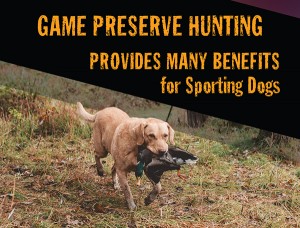Game Preserve Hunting Provides Many Benefits for Sporting Dogs
Click here to read the complete article
It’s an old adage, and, unlike some of the old adages, this one actually is true: It takes birds to make a gun dog. Certainly, you can train virtually any sporting dog without using birds, at least to a functional level. But, it’s not efficient and it’s not easy.
While, of course, the best of all worlds would be to have a place to hunt and train that was loaded with wild birds, that sort of idyllic Eden rarely exists these days. To put the reason for this rare occurrence in very simple terms, loss of habitat has created a sharp decline not just of game birds but also songbirds virtually everywhere in the U.S. Upland birds such as pheasants, quail and chukars need food, nesting cover, loafing cover and escape cover. In northern tier states, they also need winter cover which means coniferous trees in groves and shelter belts. Waterfowl need food along with nesting and escape cover as well as wetlands.
For those readers of The Canine Chronicle interested in how and why the loss of habitat and the resultant declining bird populations has occurred, here’s a brief answer. The trend toward larger and larger farming operations with the emphasis on row crops–corn and soybeans being the most prevalent–has destroyed much of the birds’ nesting and escape cover as farmers are strongly encouraged to plant fencerow-to-fencerow by their bankers in order to eke every possible bit of revenue from their tillable land. Drainage practices that date back to the 1930s, many of which have been strongly encouraged by the U.S. Department of Agriculture, have also eliminated roughly half of the nation’s wetlands, according to studies done by the U.S. Fish and Wildlife Service. These wetlands and the land not suitable for tillage around them because of fluctuating water levels in the wetland itself also provided food and cover not just for waterfowl but for many upland birds and for many songbird species as well. Commodity prices have encouraged farmers to withdraw croplands from the Conservation Reserve Program when their contracts ended and this financial reality has hastened the loss of the remaining habitat. In addition, the protected status of aerial predators–eagles, falcons, hawks and owls–has also had an effect on bird populations as have fashion trends, especially those that have made it politically incorrect to wear fur such as fox, wolf, coyote and raccoon. While wildlife biologists contend that predation has little long-term effect on bird populations, they do concede that it has some. Also, in some states like Minnesota for example, the state’s department of natural resources has little interest in any game species whose name does not begin with the letter “W,” in other words walleyed pike and white-tailed deer, which pretty much eliminates any emphasis on promoting habitat for game birds. All of these factors are why finding a place with large populations of wild birds for your dog to hunt is a near impossibility these days.
Click here to read the complete article
Short URL: https://caninechronicle.com/?p=181418
Comments are closed












